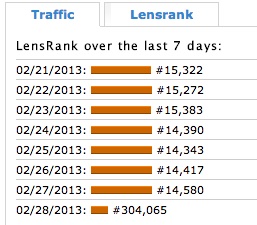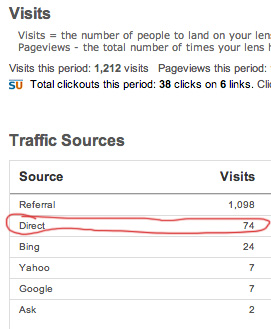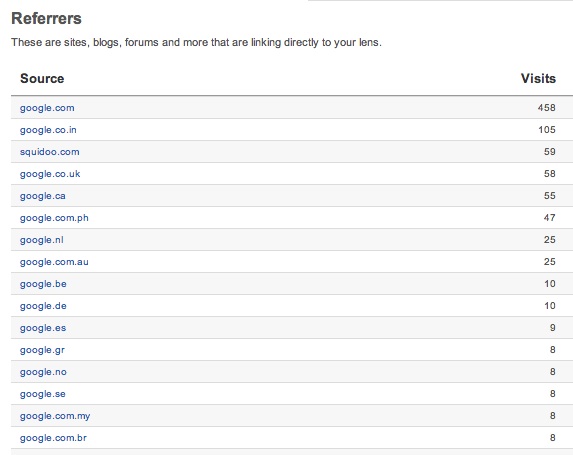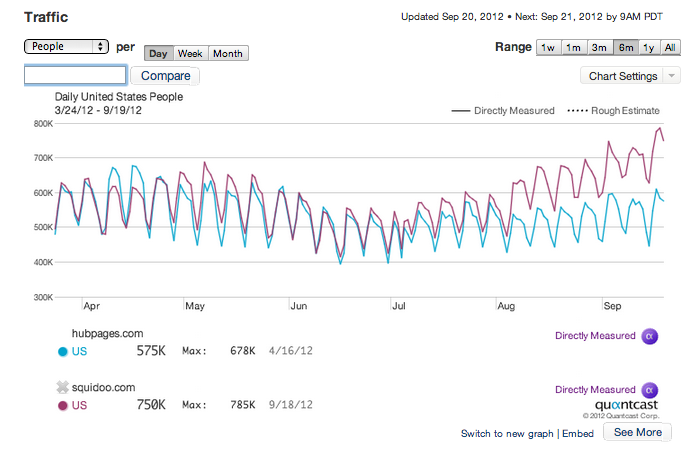For years, veteran Squidoo lensmasters have been tearing their hair that some thin-content, “pile of links” lenses get promoted, showcased on the front page of Squidoo, and earn payouts, while more content-rich lenses like this sink in lensrank until they fall into WIP mode, get noindexed, and thus become invisible to search engines, cutting off their traffic.
So we should be happy that Squidoo HQ has raised the issue that we have raised for years, although I feel bad for the targeted lensmaster. But here’s the catch.
Check out the recent lensrank of the lens that HQ decided to make an example of as a “spammy lens.”
And here’s its traffic:
Prior to HQ’s Feb 27 post, what we see is the natural, organic search traffic the lens was getting. It drew daily traffic, for all that it was a pretty thin-content page. So apparently some people were finding it useful, or at least finding it.
Ironically, all the visits sent by HQ’s blog post precede a next-day lensrank tumble. I suspect that some kind of manually-applied lensrank penalty may be at work, so we can’t draw general conclusions from the tumble. But before that, we see that a thin-content, “list of product links” lens can naturally rank in the 15K-14K range, whereas thousands of lenses with more substantial content rank lower.
Here and elsewhere, we’ve seen that Squidoo’s lensrank algorithm rewards lenses like the one HQ has held up as an example of what not to do. Various theories have been espoused as to why:
- The front page of Squidoo often showcases lenses with thin content just like this one, boosting the lensrank of those lenses
- Like exchange groups on Facebook artificially promote spammy lenses via internal traffic rather than organic
- Soliciting of likes is now encouraged on the official forums
- Many Squidquests tell lensmasters to run around liking lenses, and in general, the points system encourages like exchanges, so people are liking things to get points not because of content
- Other Squidquests award points for people nominating lenses in various categories for purple stars, and so people look for and nominate random lenses in various categories to get points. Purple stars provide lensrank boosts.
- Lensmasters now receive “angel” wings automatically, and are encouraged to bless and rank up lenses with no guidance or training to tell them what’s bless-worthy
- Fivr gigs, bots and services have sprung up selling traffic and likes to Squidoo lenses
- ETA: When “Monsters” were added to Squidoo in fall 2010, it changed the thrust of the site from publishing content and earning readers to gaming and earning points. Is it any wonder that content has suffered, while gaming the system has increased? (Remember, before monsters were introduced, likes and blessings were anonymous).
I’m not sure which of these factors is signficant, and which are just offensive to our sensibilities but fail to have a real impact on lensrank. HQ is in a better position to judge.
The bottom line is that the top tiers are saturated with lenses similar to the one held up by HQ as “Never do this.” These lenses set an example of what earns money on Squidoo. Lensmasters see them, see what gets rewarded with a good lensrank, and imitate, imitate, imitate, trying to capitalize on the same success.
At which point, telling people “don’t do it!” is like wagging a finger at athletes not to take performance enhancing drugs when many news headlines, awards, and good salaries are going to stars taking performance enhancing drugs. Nothing will change until you make sure the problematic behavior is not getting rewarded.
Translation: Blame the lensrank algorithm, not just the lensmasters chasing it. And fix it.
There are bigger forces at work here, however. I can’t help but see Bonnie’s post in the larger context of what’s been happening on Squidoo lately as a whole.
Yep, I’m talking traffic fluctuations. As usual, I use Hubpages as a comparable site and yardstick against which to measure Squidoo’s traffic fortunes. Until November 2012, when Panda 22 took a noticeable bite out of Squidoo’s overall traffic and rankings, Google always seemed to leave Squidoo alone and use Hubpages as a punching bag. Now, abruptly, Squidoo’s traffic levels have fallen down to Hubpages’ levels (and even below):

— Source: Quantcast.com
Look at mid-February. This is not a typical traffic pattern for Squidoo; in past years its traffic has been fairly steady from January through March.
This means that something has happened in the past few months. Either Google has done a massive algorithm change — in which case we’d be hearing about it across the SEO blogosphere and on these Google timelines maintained by Sistrix and SEOmoz — or some sort of recent changes on Squidoo have caused it to fall out of Google’s good graces, after years of navigating the stormy waters of Panda and Penguin without a wobble.
Are spammy lenses like the one Bonnie just fingerpointed a new phenomenon on Squidoo? No. They’re annoying, and they’ve not helped Squidoo’s reputation, but Google has never given Squidoo a hard time about them before, because Squidoo has a lot of meatier, in-depth content, too. So, if those aren’t anything new, what is new on Squidoo?
The biggest recent change has been Squidoo’s responsive layout redesign.
Starting in December, Squidoo redesigned the website, hoping to make it more mobile-friendly.
- Many lenses actually became less mobile-friendly as a result, since hand-coded layouts were mangled by the change. Lensmasters have needed to go back and fix these layout problems manually, and many lenses— perhaps thousands— have not yet been fixed.
- The responsive layout often pushes sidebar ads down to the bottom, then adds more ads to the body text area of the lens, between paragraphs and modules. This occurs not just on mobile devices, but even on very wide screen monitors and large browser windows which previously accommodated Squidoo’s sidebar and body column. I’ve also seen extra advertising appearing at the top of lenses on my tablet.
Too much “above the fold” and intrusive advertising causes websites to be downranked by Google’s “Top Heavy” algorithm. I’ve argued since 2011 that Squidoo’s inefficient use of “above the fold” space risked incurring this penalty, yet I was wrong: somehow, Squidoo always managed to squeak by. But now that we’ve got ads smack dab in the body text of the lens — where Hubpages has always had a block of ads, and until now has always fared worse from Google than Squidoo has — Squidoo’s traffic levels have fallen to Hubpages levels. Coincidence?
Also starting in December November, Squidoo became a Crowdignite affiliate (see Google’s warnings about Link Schemes). This did three things.
- Crowdignite links now replace the “Related lenses” box in the sidebar of Squidoo lenses, unless we specify “related lenses” manually. So before, Squidoo lenses cross-linked to good on-site content that was relevant, boosting relevance on both sides of the link and keeping pagerank within Squidoo. Whereas now, most Squidoo lenses cross-link to CrowdIgnite content that may not be as relevant and which siphons pagerank away. This is a huge SEO change.
- Crowdignite and Squidoo are basically creating an artificial traffic exchange. It’s not a paid traffic exchange, which would likely incur some kind of penalty, but it’s not something that Google recommends.
- Moreover, to hold up its side of this traffic exchange, Crowdignite takes and republishes Squidoo content elsewhere.
This is also huge. In the past, Squidoo did not distribute lens content to other websites. But now, according to Crowdignite’s TOS, “By registering a website on the Service, you expressly grant, and you represent and warrant that you have a right to grant, to Company a royalty-free, sublicensable, transferable, perpetual, irrevocable, non-exclusive, worldwide license to use, reproduce, modify, publish, hyperlink, list information regarding, edit, translate, distribute, publicly perform, publicly display, and make derivative works of all content displayed on any page of your website.”
This means the content we post on Squidoo is no longer found only on Squidoo. I don’t know where CrowdIgnite is redistributing our content, or how much of Squidoo’s total content is being duplicated on CrowdIgnite’s other affiliate sites. All we know is that CrowdIgnite is duplicating lens content off-Squidoo.
Duplicate content, folks. Again, I can’t be sure this has anything to do with Squidoo’s recent traffic woes, but the timing is suspicious.
However, I don’t know how to test whether this duplicate content, Crowdignite’s traffic exchange, additional ads, or layout problems are in fact causing Google to downrank us. Those are just educated guesses, based on my knowledge of what kinds of factors have gotten other sites clobbered by Google algorithms in the past.
So how does this tie back into Bonnie’s post about spammy sales lenses?
Squidoo has a traffic problem. Its traffic and revenue are falling. I was waiting to see what kind of steps HQ was going to take to address this problem.
While I worry that too many thin-content lenses like the one Bonnie fingerpointed could lead to Google penalties, they have been part of Squidoo for years and have not cost Squidoo.com any Google rankings; they simply took away Squidoo tier payouts from other, possibly more deserving lenses. Whereas now, it looks like something else is costing the site Google rankings. I hope HQ is investigating what that “something else” might be.
[UPDATE: HQ has now identified at least one possible culprit: a recent flood of “spun lenses.”]













